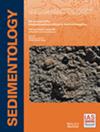高镁方解石骨架为白垩纪碳酸盐岩的洞穴选择性白云化提供镁
IF 2.8
2区 地球科学
Q1 GEOLOGY
引用次数: 0
摘要
镁的来源和泵送机制在白云化过程中起着至关重要的作用。地穴的优先白云化现象在地质档案中有广泛的记载。尽管白垩纪碳酸盐岩中大量保存了洞穴,但由于海水的低Mg/Ca比,在正常盐度的海洋环境中,洞穴选择性白云化并不常见。然而,在阿拉伯地台的Cenomanian Rumaila组碳酸盐岩中发生的洞穴选择性白云化为进一步阐明洞穴选择性白云化的机制和探索其他潜在的镁源提供了一个很好的例子。结合岩石学、稳定同位素地球化学和基于激光烧蚀-电感耦合等离子体质谱的原位元素地球化学进行了综合研究。研究发现,洞选择性白云化作用只发生在棘皮动物碎片填充的海assinoides网络中,这些网络以Glossifungites技术相的形式出现。洞状白云岩呈细晶至中晶、平面亚面体至自面体织构,中心浑浊,边缘清晰。它们表现出相对较高的Mn、较低的Sr和Fe浓度,没有或非常弱的负Ce异常和中稀土元素-凸起模式,相对于周围方解石基质,δ 13c和δ 18o相对较少富集。洞穴中最初的高镁方解石棘皮碎片已经稳定为低镁方解石,并且棘皮合成过度生长的方解石胶结几乎不存在。棘皮动物碎片经常被部分或全部的白云石所取代。未钼矿化棘皮动物具有负Ce异常和类似海水的稀土元素模式,Mn、Fe含量非常低,Sr含量相对较高。这表明,在沉积物-水界面附近的含氧海水中,有机物的好氧分解驱动高Mg方解石在流体不饱和中发生棘皮稳定,同时Mg离子被释放到孔隙水中。这一过程提前了白云化的发生,使得棘皮动物体内的镁元素提高了洞穴间质水的镁/钙比值。洞内白云岩是在近地表低温和缺氧流体中由细菌硫酸盐还原和甲烷生成作用引起的初始置换和随后的过度生长胶结作用形成的,随着埋深的增加,白云岩逐渐重结晶。本研究揭示了棘皮动物的稳定过程,将骨骼的早期成岩作用与洞穴白云化联系起来,并提出了一个概念模型,说明高镁方解石骨架可能是洞穴选择性白云化的主要镁源,弥补了白垩纪正常低Mg/Ca比海水中Mg的不足。本研究揭示了早期成岩系统中各组分之间的相互作用和元素循环,并验证了高镁方解石确实是部分或选择性白云化不可忽视的潜在镁源。本文章由计算机程序翻译,如有差异,请以英文原文为准。
High‐magnesium calcite skeletons provide magnesium for burrow‐selective dolomitization in Cretaceous carbonates
ABSTRACT The source and pumping mechanism of magnesium play crucial roles in dolomitization. The preferential dolomitization of burrows has been extensively documented in geological archives. Although burrows are abundantly preserved in Cretaceous carbonates, burrow‐selective dolomitization is uncommon in normal salinity marine environments due to the low Mg/Ca ratio of seawater. However, burrow‐selective dolomitization occurred in the Cenomanian Rumaila Formation carbonates of the Arabian Platform providing an excellent example to further clarify the mechanism and explore other potential Mg sources of burrow‐elective dolomitization. Integrated studies of petrography, stable isotope geochemistry and laser ablation–inductively coupled plasma–mass spectrometry‐based in situ element geochemistry were conducted. It was found that the burrow‐selective dolomitization exclusively occurred in echinoderm fragment‐filled Thalassinoides networks which occurred as Glossifungites ichnofacies. Burrow dolomites showed fine to medium crystalline and planar subhedral to euhedral textures with cloudy centres and clear rims. They exhibited relatively greater Mn, lower Sr and Fe concentrations, no or very weak negative Ce anomaly and middle rare earth element‐bulge patterns, and are slightly enriched with occasionally depleted δ 13 C and comparable δ 18 O relative to the surrounding calcite matrix. The initial high‐Mg calcite echinoderm fragments in burrows have been stabilized to low‐Mg calcite, and echinoderm syntaxial overgrowth calcite cement was practically nonexistent. Echinoderm fragments were frequently replaced by dolomite in part or whole. Undolomitized echinoderms have negative Ce anomaly and seawater‐like rare earth element patterns, as well as very low Mn, Fe and relatively greater Sr concentrations. These suggest that echinoderm stabilization occurred in fluid unsaturated with respect to high‐Mg calcite driven by aerobic decomposition of organic matter in oxic seawater near the sediment–water interface, meanwhile, Mg ions were liberated into pore water. This process pre‐dated the dolomitization allowing the Mg derived from echinoderm to raise the Mg/Ca ratio of burrow interstitial water. The dolomites in burrows were generated by initial replacement and subsequent overgrowth cementation associated with bacterial sulphate reduction and methanogenesis in low‐temperature and suboxic to anoxic fluids in the near‐surface realm, and faintly recrystallized as burial depth increased. This study sheds light on the echinoderm stabilization process, links the early diagenesis of skeletons to burrow dolomitization, and proposes a conceptual model illustrating that high‐Mg calcite skeletons could act as a major Mg source for burrow‐selective dolomitization, which compensates for the deficiency of Mg in normal low Mg/Ca ratio Cretaceous seawater. This study implies the interaction effect and element cycle among components in early diagenetic systems, and verifies that high‐Mg calcite is indeed a non‐negligible potential Mg source for partial or elective dolomitization.
求助全文
通过发布文献求助,成功后即可免费获取论文全文。
去求助
来源期刊

Sedimentology
地学-地质学
CiteScore
8.20
自引率
11.40%
发文量
94
审稿时长
6-12 weeks
期刊介绍:
The international leader in its field, Sedimentology publishes ground-breaking research from across the spectrum of sedimentology, sedimentary geology and sedimentary geochemistry.
Areas covered include: experimental and theoretical grain transport; sediment fluxes; modern and ancient sedimentary environments; sequence stratigraphy sediment-organism interaction; palaeosoils; diagenesis; stable isotope geochemistry; environmental sedimentology
 求助内容:
求助内容: 应助结果提醒方式:
应助结果提醒方式:


